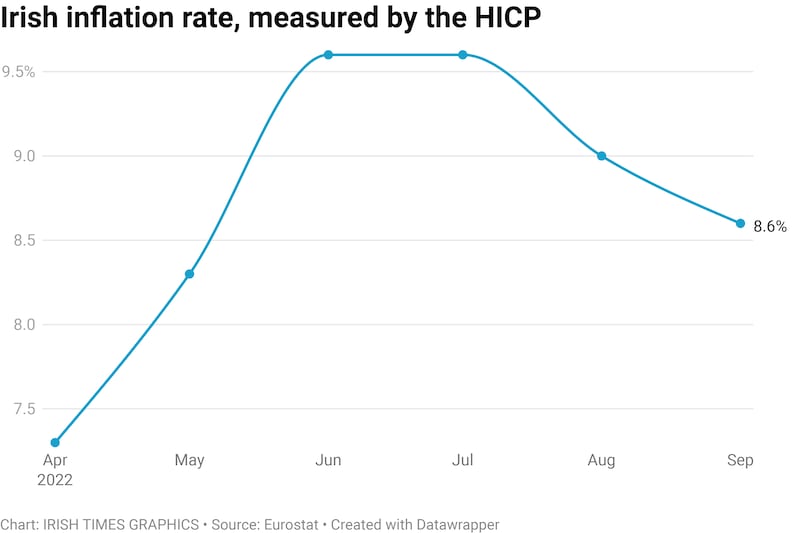Irish inflation, as measured by the European Union, eased marginally in September even as prices increased at a record annual pace across Europe.
The harmonised index of consumer prices for Ireland rose 8.6 per cent in September compared with a year earlier, Eurostat said in a statement. That compared with a 9 per cent gain in the year to August.
Commenting on the data, Anthony Dawson, a statistician in the prices division of the Central Statistics Office, said that just three of the 19 euro-zone countries had a lower annual increase than the estimate of 8.6 per cent for Ireland while 15 countries had higher rates. Estonia had the highest estimated annual inflation at 24.2 per cent while France had the lowest at 6.2 per cent.

Mr Dawson said the estimates, which are subject to revision when they are finalised next month, suggest that Irish energy prices remained static in September but were up 38 per cent over the year.
Your work questions answered: Can bonuses be deducted pro-rata during a maternity leave?
Palantir, company at centre of row surrounding TD Eoin Hayes, is no stranger to controversy at home or abroad
Tips for avoiding a January credit-card hangover
Can I work for my foreign employer from my home in Ireland?
“For the euro zone overall, energy prices were up 3 per cent in the month and up by 40.8 per cent on an annual basis,” he said.
While inflation in Ireland slowed, the euro zone’s economic crisis intensified with its first ever double-digit reading for inflation, piling pressure on the European Central Bank to keep raising interest rates aggressively.
Consumer prices surged 10 per cent from a year ago in September, the Eurostat data showed. That was more than the median forecast of 9.7 per cent in a Bloomberg survey of economists, and marks the fifth straight month the result has exceeded consensus.
Energy and food once again drove inflation, though an underlying measure that excludes them also topped estimates to reach an all-time high of 4.8 per cent.
Such data have proven critical in driving momentum toward large rate hikes in previous months, and this result is likely to embolden calls for another large move at the next ECB rate-setting meeting on October 27th. Investors this week began pricing in a second straight 75 basis-point increase.
“The next step still has to be big because we are still far away from rates that are consistent with 2 per cent inflation, ECB governing council member Martins Kazaks said on Wednesday in an interview in Vilnius, Lithuania, where price growth was 22.5 per cent. “I would side with 75 basis points.”
While officials ramped up their aggression with a move of that size on September 8th, they’ve also sought to differentiate the euro zone’s experience with that of the United States, insisting that inflation in their own region is far more supply-driven than the demand-propelled consumer-price situation across the Atlantic.
Even so, policymakers will be nervous at yet another record reading. Boris Vujcic, the Croatian central-bank governor who will join the ECB governing council in January, warned in an interview published this week that “when inflation is high, when it nears double-digit levels, it can become a disease in itself”.
With Russia starving Europe of gas supplies and winter approaching, policymakers are bracing for an even more difficult few months. Price increases may yet accelerate further in some countries, while recessions are becoming increasingly likely.
The latest OECD forecasts chime with that view. Officials on Monday raised their projection for euro-zone inflation next year by 1.6 percentage points to 6.2 per cent, noticeably exceeding the ECB’s own outlook. Hours later, ECB president Christine Lagarde reiterated that her officials also see the danger of a higher outcome.
“The risks to the inflation outlook are primarily on the upside, mainly reflecting the possibility of further major disruptions in energy supplies, she told legislators. “We expect to raise interest rates further over the next several meetings to dampen demand and guard against the risk of a persistent upward shift in inflation expectations.”
A relatively tight labour market may intensify such pressures. A separate report from Eurostat showed euro-zone unemployment held at a record-low 6.6 per cent in August.
Before the inflation data, every one of the 40 economists surveyed by Bloomberg predicted a record outcome this month, with four reckoning on 10 per cent.
The actual result masked considerable divergence across the euro region. In Germany, Europe’s biggest economy, price growth surged much more than expected.
The end of summer discounts on public transport and fuel helped drive a gain there to 10.9 per cent, the highest headline rate seen in the Group-of-Seven industrialised economies since the energy crisis struck. Italy, the Netherlands and Belgium saw significant accelerations too.
By contrast, price growth unexpectedly slowed in France and weakened much more than expected in Spain. — Additional reporting: Bloomberg






